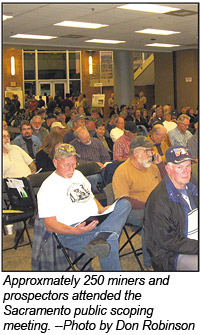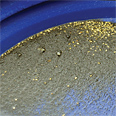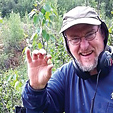All Articles
Strong Support at Suction Dredge Meetings
December 2009 by Scott Harn
Just prior to press time, we made our way to Sacramento for the second public scoping meeting to comment on the first draft of the California Department of Fish and Game (DFG) suction dredge permitting program for the new Environmental Impact Report.
The meeting room was filled with approximately 250 miners and prospectors. (Those who attended the first scoping meeting in Fresno the previous day stated there were about 80 people in attendance.)
The meeting began with an informal “meet and greet” where attendees could ask questions of staff members prior to the formal meeting.
Michael Stopher, environmental project manager for DFG, opened the meeting by explaining how the current moratorium on suction dredging came about as a result of SB670 and the lawsuit filed in Alameda County by the Karuk Tribe of California.
Michael Stevenson, project leader with Horizon Water & Environment explained the rulemaking process. Horizon is the firm that was hired by the State of California to handle the EIR process and ensure that the process follows the rules set forth in the California Environmental Quality Act. He stated that all questions and concerns gathered by mail, email, and in the public scoping meetings will be compiled in a scoping report, and each question or concern will be answered by a staff member. The next step will be a draft EIR, which will come in the summer or fall of 2010, followed by another opportunity for public input, including public hearings where concerned miners will be allowed to comment on the record. A final EIR is not expected until spring 2011, which will be followed by a Notice of Determination and CEQA findings.
When the actual meeting began, DFG controlled the format and frustrated miners by not allowing us the opportunity to speak in a standard question and answer format. Much to the dismay of those in attendance, we were asked to fill out cards with questions for the staff to review and answer. No follow up questions were allowed.
Stopher answered many of the written questions himself, with assistance from the staff of Horizon when needed.
At least one serious question was answered during this period: A Horizon staff member declared that methylmercury is not a concern for suction dredging regulations. He explained that mercury does not become methylmercury after it is passed through a dredge.

Stopher refused to answer several important concerns. He stated he could not answer questions regarding the federal lawsuit filed by Public Lands for the People that would enjoin the State of California from enforcing SB670. He also refused to define the term “deleterious” as it applies to the effects of suction dredging. Stopher stated these items were currently being litigated so he was not allowed to discuss them.
Stopher said that some suction dredge miners who held permits in the past year will be receiving surveys. The surveys will ask for detailed information regarding spending activity and the amount of gold found so the agency can determine the economic impact of suction dredging in California.
It is extremely important for those who receive surveys to list all related spending and account for every speck of gold found so the State can get a true picture of what miners contribute to the economy of California. Although this information is not required by CEQA, it is considered as a factor later in the rulemaking process.
Miners will not have to wait until 2011 for the EIR to be completed before they get back in the water if the federal lawsuit filed by PLP is settled in favor of the miners before then.
Be sure to check the “Recent News” section of our website for more updates.![]()
Dredging Safety: Don't Ignore The Warning Signs
 At first, I tried to shift things around, but then a hand with a rock would appear, so I would stop trying to adjust my gear and grab the rock to keep things moving.
At first, I tried to shift things around, but then a hand with a rock would appear, so I would stop trying to adjust my gear and grab the rock to keep things moving.
Ask The Experts
What are these rocks?
Gold Prospecting & Mining Summit Exceeds Expectations
 Brian...had cleared off some virgin, gold-bearing bedrock areas prior to our arrival, so everyone had ample opportunity to find and take home some gold.
Brian...had cleared off some virgin, gold-bearing bedrock areas prior to our arrival, so everyone had ample opportunity to find and take home some gold.
New Silver and Zinc Mine Slated for Montana
Arizona-based International Silver Inc. is proposing an underground silver and zinc mine in Montana and has asked Butte-Silver Bow County to lease them the surface and mineral rights to hundreds of acres.
The Bawl Mill
• California Governor buys more votes
• The Bank of the EPA
• Just put it on my card
Legislative and Regulatory Update
• Bush lets Roadless Rule take effect while promising changes
• USFS seeks comments for Utah forest
• A bold move by a small town
• Forest Service wants to encourage return of Canada lynx
• Update on Oregon's Measure 7
Subscription Required:
The Bawl Mill
• Legislative and Regulatory Update
• Small-Scale Mining, Milling and Recovery
• Judge Rules Against Oregon Miner
• Shirttail Creek
• A Modern Gold Rush In Sudan
• Double-D Coils and Their Place in the Goldfields
• Melman on Gold & Silver
Free:
Golden Hope's Bellechasse Gold Project
• Where to Prospect for Gold in Colorado









